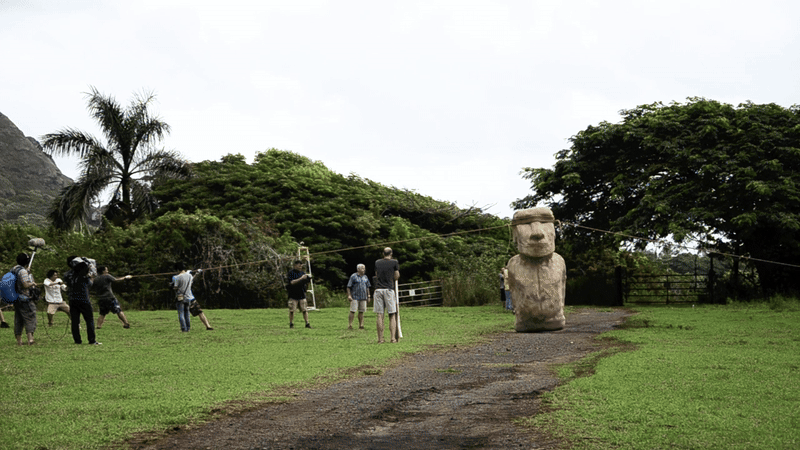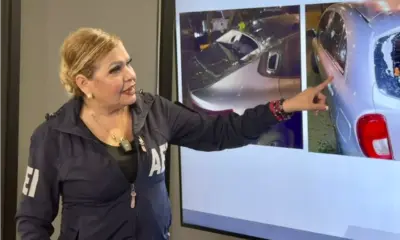Science
Easter Island’s Moai Statues Could Have “Walked” with Minimal Effort

Easter Island’s iconic moai statues, some weighing several tons, may have been moved using a method that allowed them to “walk” with just a small group of people. A recent study published in the November 2025 issue of the Journal of Archaeological Science reveals that with the right combination of ropes and an understanding of pendulum dynamics, as few as 15 individuals could have transported these massive stone figures across the island.
For centuries, the question of how the Indigenous people of Easter Island, known as Rapa Nui, managed to relocate these towering statues has sparked considerable debate. Researchers have traditionally believed that moving the moai required a large workforce and significant resources. However, the latest findings challenge this view by demonstrating that physics played a crucial role in the transportation process.
The research team, led by Carl Lipo, a professor of anthropology at Binghamton University, and Terry Hunt from the University of Arizona, examined discarded, unfinished moai that had been left in quarries. They discovered that these statues were intentionally designed with a low center of mass and a forward lean, aiding their movement.
Using virtual 3D models of the moai, the researchers calculated that a team of between five and 60 people could generate steps averaging 35 inches (89 centimeters) long, facilitating a journey across the rugged Rapa Nui terrain. The study posits that this approach provides compelling evidence against the previously accepted notion that extensive labor was necessary for moving the statues from the Rano Raraku quarry to their ceremonial sites, often as far as 6.2 miles (10 kilometers) away.
In a televised experiment in 2012, Lipo and his team successfully demonstrated this “walking” technique using a scaled replica weighing 4.8 tons (4.4 metric tons), moving it a distance of 328 feet (100 meters) in just 40 minutes. Although he acknowledged that their previous experiments lacked a rigorous exploration of the physics involved, Lipo expressed confidence in the efficiency of the method they subsequently modeled.
The study revealed that the moai’s unique forward lean, ranging between 6 to 15 degrees, allowed the statues to rock sideways during movement, effectively simulating a walking motion. The researchers noted that the D-shaped bases of the road moai acted as pivot points, further facilitating this process. The absence of eye sockets in these unfinished statues indicates that final touches were completed only after they reached their intended locations.
To understand the workforce dynamics better, the team modeled the physics of the moai’s movement, calculating that 15 to 60 people would be required to initiate the motion, with only five to 25 needed to maintain it. This suggested that the method of transport was not only innovative but also highly efficient. Once initiated, the pendulum dynamics made each subsequent step easier, allowing the statues to cover distances at an average pace of 1,000 feet (310 meters) per hour.
The implications of this research extend beyond mere mechanics. According to Sue Hamilton, an archaeologist and professor at University College London, the findings contribute significantly to the ongoing discussion about the capabilities of Rapa Nui’s ancient inhabitants. While she acknowledged the study’s ingenuity, Hamilton noted that the data could support various interpretations of the moai’s transportation methods.
Despite the enthusiasm surrounding the study, Hamilton cautioned that it does not definitively prove that the statues were moved in this manner. She emphasized that alternative hypotheses exist, suggesting that the road moai could have been engineered for different ceremonial purposes or by varying levels of expertise.
For Lipo and Hunt, who stand by their findings, the challenge remains for critics of the “walking” moai hypothesis to provide equally plausible alternatives that encompass the full spectrum of evidence. As research continues, understanding the techniques employed by the Rapa Nui people may offer deeper insights into their societal organization and ingenuity.
-

 Business4 days ago
Business4 days agoInvestors Eye Potential $60,000 Gains with Ozak AI Token
-

 Business5 days ago
Business5 days agoQuotient Wealth Partners Adjusts Holdings in iShares Russell 1000 ETF
-

 Politics5 days ago
Politics5 days agoFormer Pastor Arrested on Human Trafficking and Indecent Charges
-

 Entertainment6 days ago
Entertainment6 days agoUtah Residents Face Resource Shortages Amid Ongoing Government Shutdown
-

 Politics4 days ago
Politics4 days agoSkip Bayless Critiques Travis Hunter’s Game Day Baptism
-

 Business6 days ago
Business6 days agoCalifornia to Ban All Plastic Bags in Grocery Stores by 2026
-

 Lifestyle5 days ago
Lifestyle5 days agoNatty from KISS OF LIFE Stuns in Micro-Shorts at Seoul Event
-

 Entertainment5 days ago
Entertainment5 days agoPete Davidson Surprises Pregnant Girlfriend with Private Jet to Concert
-

 Science5 days ago
Science5 days agoCommunity Mourns Loss of Judith Ernst, Pioneer Educator at 81
-

 Entertainment6 days ago
Entertainment6 days agoEastside Kings Festival Celebrates Austin’s Rich Blues and Jazz Heritage
-

 Entertainment5 days ago
Entertainment5 days agoAce Frehley, KISS Guitarist, Passes Away at 74 After Fall
-

 World6 days ago
World6 days agoForensic Experts Identify Bodies Returned to Gaza Amid Ongoing Uncertainty









